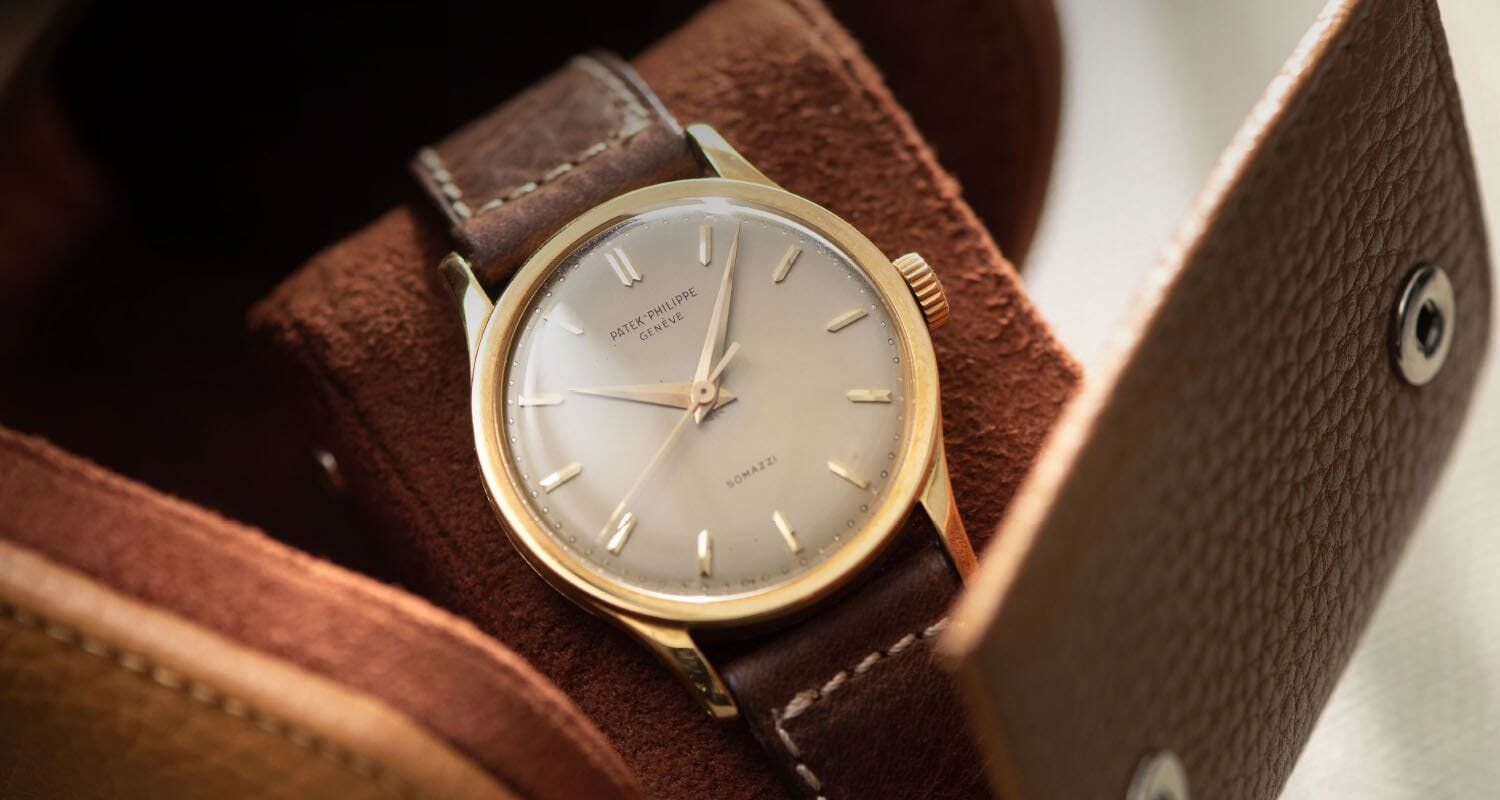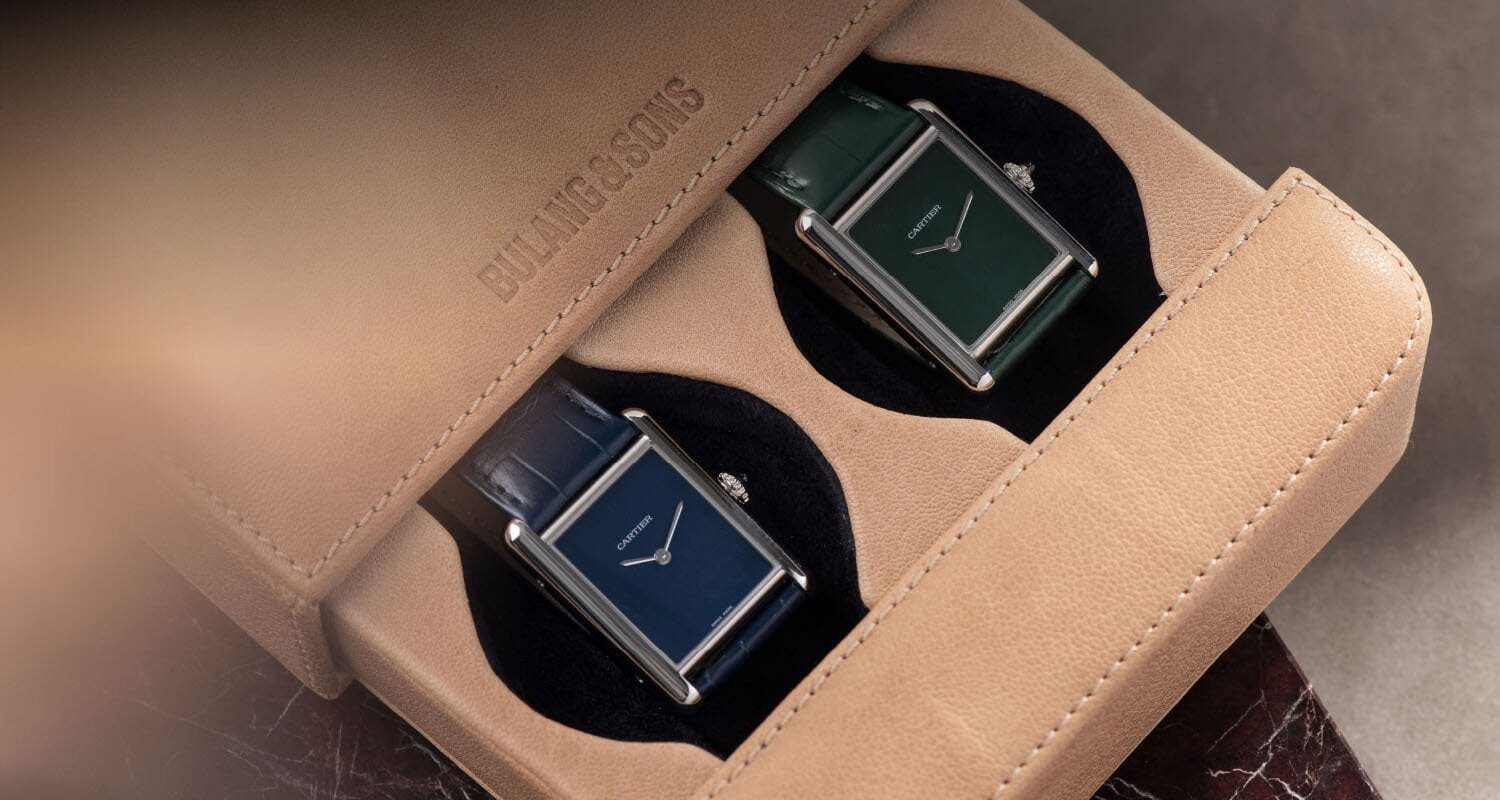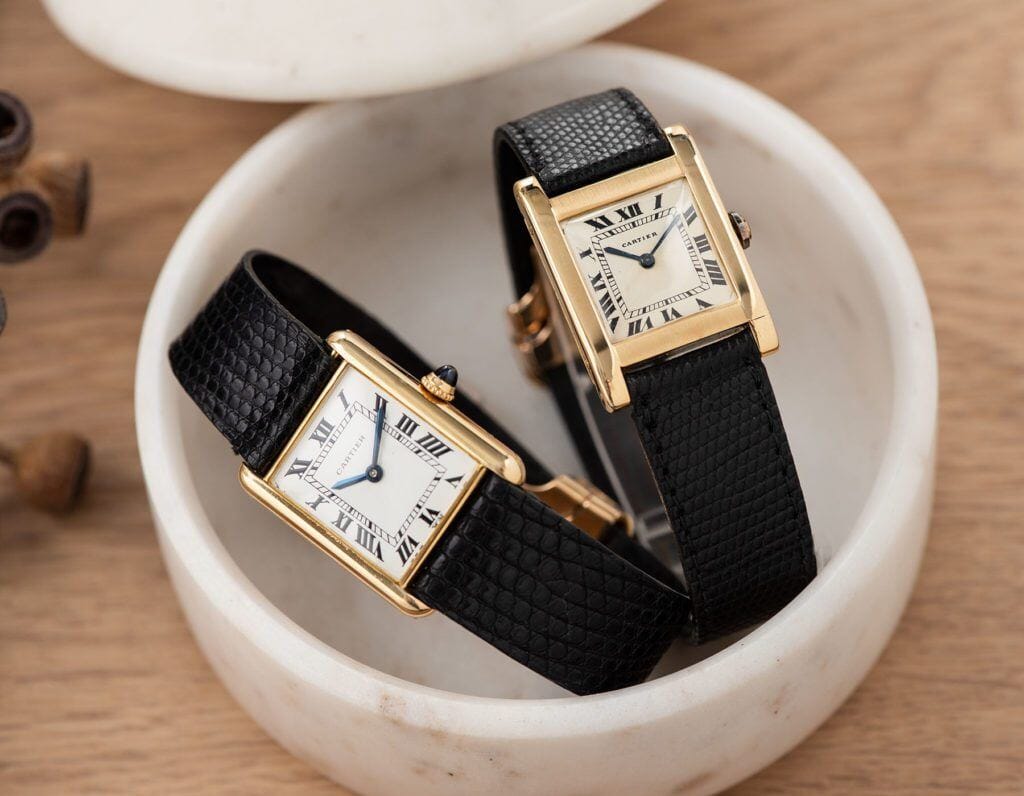
The Patek Philippe Calatrava’s Early Years
Next year marks 90 years since the introduction of arguably one of the most importantly influential watch designs of the 20th century, the Patek Philippe Calatrava. Launched in 1932 it was designed by a gentleman called David Penney and was heavily inspired by the Bauhaus movement. In-line with the ideology behind Bauhaus, the original Calatrava reference 96, was a very clean and functional looking watch that combined the beautiful high-end craftmanship for which Patek was renowned with the latest in movement technology.
This movement was provided by Jaeger LeCoultre, as the brand was not producing its own movements at the time. The 31mm watch was new and part of a movement towards wristwatches post-World War 1, in a horological world that at the time was still dominated by pocket watches. It set a template for some of Patek’s most timeless, elegant and collectible watches and it is still a favourite of collectors in today’s Patek Philippe offerings. Today we take a look at some of our favourite Calatravas and share our love for these classic watches…
As we mentioned above, the Calatrava was born as reference 96 in 1932 and was the first watch launched under the brand’s new owners, the Stern brothers who bought the company name the same year. The name Calatrava comes from the brand’s logo, the calatrava cross which the brand had actually registered in 1887 but had not, up until 1932, actually used. The Calatrava Knights of Spain and Portugal had used the cross as their flag in the 12th century and from 1932 it became Patek’s logo and the moniker for its most enduring wristwatch. Two years into the reference 96’s life, Patek began using its in-house movement the calibre 12”’120 and this became the reference 96 Calatrava’s beating heart from its introduction in 1934 until 1973.

 The watch was a simple and utterly timeless looking watch, with round case and Bauhuas-inspired less is more and form follows function aesthetic. The clean dial with applied or lapped hour markers was often paired with dauphine or leaf hands and had the balanced presence of a small seconds in the lower half of the dial. It’s important to note, however, that as simple and understated as they were, these were some of the most expensive watches on the market in the 1930s to 1950s. Launching the reference 96 was a shrewd move by the brothers Jean and Charles Stern, who owned a successful dial manufacture, and was the genesis of Patek becoming the giant it is today.
The watch was a simple and utterly timeless looking watch, with round case and Bauhuas-inspired less is more and form follows function aesthetic. The clean dial with applied or lapped hour markers was often paired with dauphine or leaf hands and had the balanced presence of a small seconds in the lower half of the dial. It’s important to note, however, that as simple and understated as they were, these were some of the most expensive watches on the market in the 1930s to 1950s. Launching the reference 96 was a shrewd move by the brothers Jean and Charles Stern, who owned a successful dial manufacture, and was the genesis of Patek becoming the giant it is today.
 The reference 96 was the first time that Patek began using number references for its models and was also one of the first watches to have the lugs integrated into the case design. It was still common in the early 1930s for the lugs to be simply soldered onto the case and so Penney’s design was important for its holistic take on the case. The three-piece case consisted of mid-case, polished bezel and snap case back. Over the models 41-year run, there were some examples with centre seconds and also seldom seen watches with no seconds hand.
The reference 96 was the first time that Patek began using number references for its models and was also one of the first watches to have the lugs integrated into the case design. It was still common in the early 1930s for the lugs to be simply soldered onto the case and so Penney’s design was important for its holistic take on the case. The three-piece case consisted of mid-case, polished bezel and snap case back. Over the models 41-year run, there were some examples with centre seconds and also seldom seen watches with no seconds hand.
 The star of the show, however, is the clean dial which did nothing but allow the wearer a simple and unobstructed view of the time. That isn’t to say that the dial wasn’t sometimes executed in different ways. Some of the most beautiful reference 96s house cool sector dials with twoe concentric circles with the inner for hours and the outer for minutes. And of course we can’t overlook arguably the most sought after of all dials, the Breguet numerals. These stylized hour markers are never hotter than when fitted to a dial in a steel case, of which Patek made a few over the 96’s four-decade run.
The star of the show, however, is the clean dial which did nothing but allow the wearer a simple and unobstructed view of the time. That isn’t to say that the dial wasn’t sometimes executed in different ways. Some of the most beautiful reference 96s house cool sector dials with twoe concentric circles with the inner for hours and the outer for minutes. And of course we can’t overlook arguably the most sought after of all dials, the Breguet numerals. These stylized hour markers are never hotter than when fitted to a dial in a steel case, of which Patek made a few over the 96’s four-decade run.
In 1938, Patek Philippe unveiled the reference 570. Essentially, the 570 was an oversized reference 96 and remained in production for 30 years. It’s not surprising that Patek made this watch, as there was a movement at the end of the 1930s for really large sized dress watches. We have always loved these oversized watches and have written about them in the past. Measuring 35.5mm, the 570 took all the styling cues of the reference 96 but in a larger size that feels very different on the wrist and is a lot more popular in the current market and we really love how they wear on the wrist.




 The reference 570 was available with both subsidiary and centre seconds and examples were made in steel, yellow, white and pink gold as well as platinum. Of course, it’s an ‘important’ watch and so there is an Italian nickname for the watch which is Calatravone which translates to large Calatrava. As with most vintage Patek watches, some of the most desirable reference 570s are those in steel cases and then even more so if they have a sector dial and the highest of all desirable fruits, the Breguet numeral dial in steel. One such example sold at Phillips’ Geneva Sale in May 2021 for an astonishing CHF 3,297,000 which illustrates just how incredible sought after these watches can be in certain configurations.
The reference 570 was available with both subsidiary and centre seconds and examples were made in steel, yellow, white and pink gold as well as platinum. Of course, it’s an ‘important’ watch and so there is an Italian nickname for the watch which is Calatravone which translates to large Calatrava. As with most vintage Patek watches, some of the most desirable reference 570s are those in steel cases and then even more so if they have a sector dial and the highest of all desirable fruits, the Breguet numeral dial in steel. One such example sold at Phillips’ Geneva Sale in May 2021 for an astonishing CHF 3,297,000 which illustrates just how incredible sought after these watches can be in certain configurations.

We love the reference 570 and have offered a couple of these watches in recent years. We are currently offering a beautiful example (link needed) in yellow gold. Housing a manual wind caliber 27sc movement the watch is in stunning condition with a deep champagne coloured dial with applied arrow-esque hour markers and dauphine hands. The example were are offering is also double signed “SOMAZZI”. Somazzi is a famous Lugano-based retailer that was established in 1860 and is still operating and run by the family today. Somazzi has been an official Patek Phillipe retailer for decades and Somazzi-signed Pateks are some of the most desirable double signed dials that collectors can find.



Alongside reference 570 was also launched the reference 565. The 565 was launched at the same time in 1938, but was a sportier watch with a more angular case and super-importantly a screw case back instead of a snap back like on the reference 96 and 570. Another interesting thing about reference 565 was that it was widely available in steel. The watch was a two-piece design, like early Rolex Osyters, with the bezel and mid-case being one to aid the waterproofness of the watch. Like the 570, examples exist in both centre and subsidiary seconds and there were a large number of dials available.

 In 1952 Patek replaced the reference 565 with reference 2533, continuing its line of manually wound waterproof wristwatches. The 2533 was aesthetically similar but with the addition of a pronounced stepped bezel cut into the case and a bevel on the upper case edge. These touches were very much in step with watch designs of the time and afforded the 2533 a new more current look when it was launched. The watch continued very much in the tradition of the earliest reference 96 though, with many examples having the applied hour markers and dauphine hands and all 2533s had centre seconds hands (there was a subsidiary seconds Calatrava available at the same time which was reference 2532 that was essentially the same watch but for the seconds configuration).
In 1952 Patek replaced the reference 565 with reference 2533, continuing its line of manually wound waterproof wristwatches. The 2533 was aesthetically similar but with the addition of a pronounced stepped bezel cut into the case and a bevel on the upper case edge. These touches were very much in step with watch designs of the time and afforded the 2533 a new more current look when it was launched. The watch continued very much in the tradition of the earliest reference 96 though, with many examples having the applied hour markers and dauphine hands and all 2533s had centre seconds hands (there was a subsidiary seconds Calatrava available at the same time which was reference 2532 that was essentially the same watch but for the seconds configuration).


 We have a superb reference 2533 available in our shop. The 34,5mm yellow gold case watch has all the sporty elements one could hope for in a vintage waterproof dress watch. The deep matte silver/champagne dial is stunning with no lume and what we have discussed quite extensively, the classic applied markers and dauphine hands. These watches are still as desirable and ‘relevant’ today as they would have been in the 1930s and 40s and have an unarguable presence and feel on the wrist that is very hard to equal.
We have a superb reference 2533 available in our shop. The 34,5mm yellow gold case watch has all the sporty elements one could hope for in a vintage waterproof dress watch. The deep matte silver/champagne dial is stunning with no lume and what we have discussed quite extensively, the classic applied markers and dauphine hands. These watches are still as desirable and ‘relevant’ today as they would have been in the 1930s and 40s and have an unarguable presence and feel on the wrist that is very hard to equal.

This movement was provided by Jaeger LeCoultre, as the brand was not producing its own movements at the time. The 31mm watch was new and part of a movement towards wristwatches post-World War 1, in a horological world that at the time was still dominated by pocket watches. It set a template for some of Patek’s most timeless, elegant and collectible watches and it is still a favourite of collectors in today’s Patek Philippe offerings. Today we take a look at some of our favourite Calatravas and share our love for these classic watches…
Reference 96
As we mentioned above, the Calatrava was born as reference 96 in 1932 and was the first watch launched under the brand’s new owners, the Stern brothers who bought the company name the same year. The name Calatrava comes from the brand’s logo, the calatrava cross which the brand had actually registered in 1887 but had not, up until 1932, actually used. The Calatrava Knights of Spain and Portugal had used the cross as their flag in the 12th century and from 1932 it became Patek’s logo and the moniker for its most enduring wristwatch. Two years into the reference 96’s life, Patek began using its in-house movement the calibre 12”’120 and this became the reference 96 Calatrava’s beating heart from its introduction in 1934 until 1973.

 The watch was a simple and utterly timeless looking watch, with round case and Bauhuas-inspired less is more and form follows function aesthetic. The clean dial with applied or lapped hour markers was often paired with dauphine or leaf hands and had the balanced presence of a small seconds in the lower half of the dial. It’s important to note, however, that as simple and understated as they were, these were some of the most expensive watches on the market in the 1930s to 1950s. Launching the reference 96 was a shrewd move by the brothers Jean and Charles Stern, who owned a successful dial manufacture, and was the genesis of Patek becoming the giant it is today.
The watch was a simple and utterly timeless looking watch, with round case and Bauhuas-inspired less is more and form follows function aesthetic. The clean dial with applied or lapped hour markers was often paired with dauphine or leaf hands and had the balanced presence of a small seconds in the lower half of the dial. It’s important to note, however, that as simple and understated as they were, these were some of the most expensive watches on the market in the 1930s to 1950s. Launching the reference 96 was a shrewd move by the brothers Jean and Charles Stern, who owned a successful dial manufacture, and was the genesis of Patek becoming the giant it is today.  The reference 96 was the first time that Patek began using number references for its models and was also one of the first watches to have the lugs integrated into the case design. It was still common in the early 1930s for the lugs to be simply soldered onto the case and so Penney’s design was important for its holistic take on the case. The three-piece case consisted of mid-case, polished bezel and snap case back. Over the models 41-year run, there were some examples with centre seconds and also seldom seen watches with no seconds hand.
The reference 96 was the first time that Patek began using number references for its models and was also one of the first watches to have the lugs integrated into the case design. It was still common in the early 1930s for the lugs to be simply soldered onto the case and so Penney’s design was important for its holistic take on the case. The three-piece case consisted of mid-case, polished bezel and snap case back. Over the models 41-year run, there were some examples with centre seconds and also seldom seen watches with no seconds hand.  The star of the show, however, is the clean dial which did nothing but allow the wearer a simple and unobstructed view of the time. That isn’t to say that the dial wasn’t sometimes executed in different ways. Some of the most beautiful reference 96s house cool sector dials with twoe concentric circles with the inner for hours and the outer for minutes. And of course we can’t overlook arguably the most sought after of all dials, the Breguet numerals. These stylized hour markers are never hotter than when fitted to a dial in a steel case, of which Patek made a few over the 96’s four-decade run.
The star of the show, however, is the clean dial which did nothing but allow the wearer a simple and unobstructed view of the time. That isn’t to say that the dial wasn’t sometimes executed in different ways. Some of the most beautiful reference 96s house cool sector dials with twoe concentric circles with the inner for hours and the outer for minutes. And of course we can’t overlook arguably the most sought after of all dials, the Breguet numerals. These stylized hour markers are never hotter than when fitted to a dial in a steel case, of which Patek made a few over the 96’s four-decade run.
Reference 570
In 1938, Patek Philippe unveiled the reference 570. Essentially, the 570 was an oversized reference 96 and remained in production for 30 years. It’s not surprising that Patek made this watch, as there was a movement at the end of the 1930s for really large sized dress watches. We have always loved these oversized watches and have written about them in the past. Measuring 35.5mm, the 570 took all the styling cues of the reference 96 but in a larger size that feels very different on the wrist and is a lot more popular in the current market and we really love how they wear on the wrist.




 The reference 570 was available with both subsidiary and centre seconds and examples were made in steel, yellow, white and pink gold as well as platinum. Of course, it’s an ‘important’ watch and so there is an Italian nickname for the watch which is Calatravone which translates to large Calatrava. As with most vintage Patek watches, some of the most desirable reference 570s are those in steel cases and then even more so if they have a sector dial and the highest of all desirable fruits, the Breguet numeral dial in steel. One such example sold at Phillips’ Geneva Sale in May 2021 for an astonishing CHF 3,297,000 which illustrates just how incredible sought after these watches can be in certain configurations.
The reference 570 was available with both subsidiary and centre seconds and examples were made in steel, yellow, white and pink gold as well as platinum. Of course, it’s an ‘important’ watch and so there is an Italian nickname for the watch which is Calatravone which translates to large Calatrava. As with most vintage Patek watches, some of the most desirable reference 570s are those in steel cases and then even more so if they have a sector dial and the highest of all desirable fruits, the Breguet numeral dial in steel. One such example sold at Phillips’ Geneva Sale in May 2021 for an astonishing CHF 3,297,000 which illustrates just how incredible sought after these watches can be in certain configurations. 
We love the reference 570 and have offered a couple of these watches in recent years. We are currently offering a beautiful example (link needed) in yellow gold. Housing a manual wind caliber 27sc movement the watch is in stunning condition with a deep champagne coloured dial with applied arrow-esque hour markers and dauphine hands. The example were are offering is also double signed “SOMAZZI”. Somazzi is a famous Lugano-based retailer that was established in 1860 and is still operating and run by the family today. Somazzi has been an official Patek Phillipe retailer for decades and Somazzi-signed Pateks are some of the most desirable double signed dials that collectors can find.



Reference 2533
Alongside reference 570 was also launched the reference 565. The 565 was launched at the same time in 1938, but was a sportier watch with a more angular case and super-importantly a screw case back instead of a snap back like on the reference 96 and 570. Another interesting thing about reference 565 was that it was widely available in steel. The watch was a two-piece design, like early Rolex Osyters, with the bezel and mid-case being one to aid the waterproofness of the watch. Like the 570, examples exist in both centre and subsidiary seconds and there were a large number of dials available.

 In 1952 Patek replaced the reference 565 with reference 2533, continuing its line of manually wound waterproof wristwatches. The 2533 was aesthetically similar but with the addition of a pronounced stepped bezel cut into the case and a bevel on the upper case edge. These touches were very much in step with watch designs of the time and afforded the 2533 a new more current look when it was launched. The watch continued very much in the tradition of the earliest reference 96 though, with many examples having the applied hour markers and dauphine hands and all 2533s had centre seconds hands (there was a subsidiary seconds Calatrava available at the same time which was reference 2532 that was essentially the same watch but for the seconds configuration).
In 1952 Patek replaced the reference 565 with reference 2533, continuing its line of manually wound waterproof wristwatches. The 2533 was aesthetically similar but with the addition of a pronounced stepped bezel cut into the case and a bevel on the upper case edge. These touches were very much in step with watch designs of the time and afforded the 2533 a new more current look when it was launched. The watch continued very much in the tradition of the earliest reference 96 though, with many examples having the applied hour markers and dauphine hands and all 2533s had centre seconds hands (there was a subsidiary seconds Calatrava available at the same time which was reference 2532 that was essentially the same watch but for the seconds configuration).

 We have a superb reference 2533 available in our shop. The 34,5mm yellow gold case watch has all the sporty elements one could hope for in a vintage waterproof dress watch. The deep matte silver/champagne dial is stunning with no lume and what we have discussed quite extensively, the classic applied markers and dauphine hands. These watches are still as desirable and ‘relevant’ today as they would have been in the 1930s and 40s and have an unarguable presence and feel on the wrist that is very hard to equal.
We have a superb reference 2533 available in our shop. The 34,5mm yellow gold case watch has all the sporty elements one could hope for in a vintage waterproof dress watch. The deep matte silver/champagne dial is stunning with no lume and what we have discussed quite extensively, the classic applied markers and dauphine hands. These watches are still as desirable and ‘relevant’ today as they would have been in the 1930s and 40s and have an unarguable presence and feel on the wrist that is very hard to equal. 


